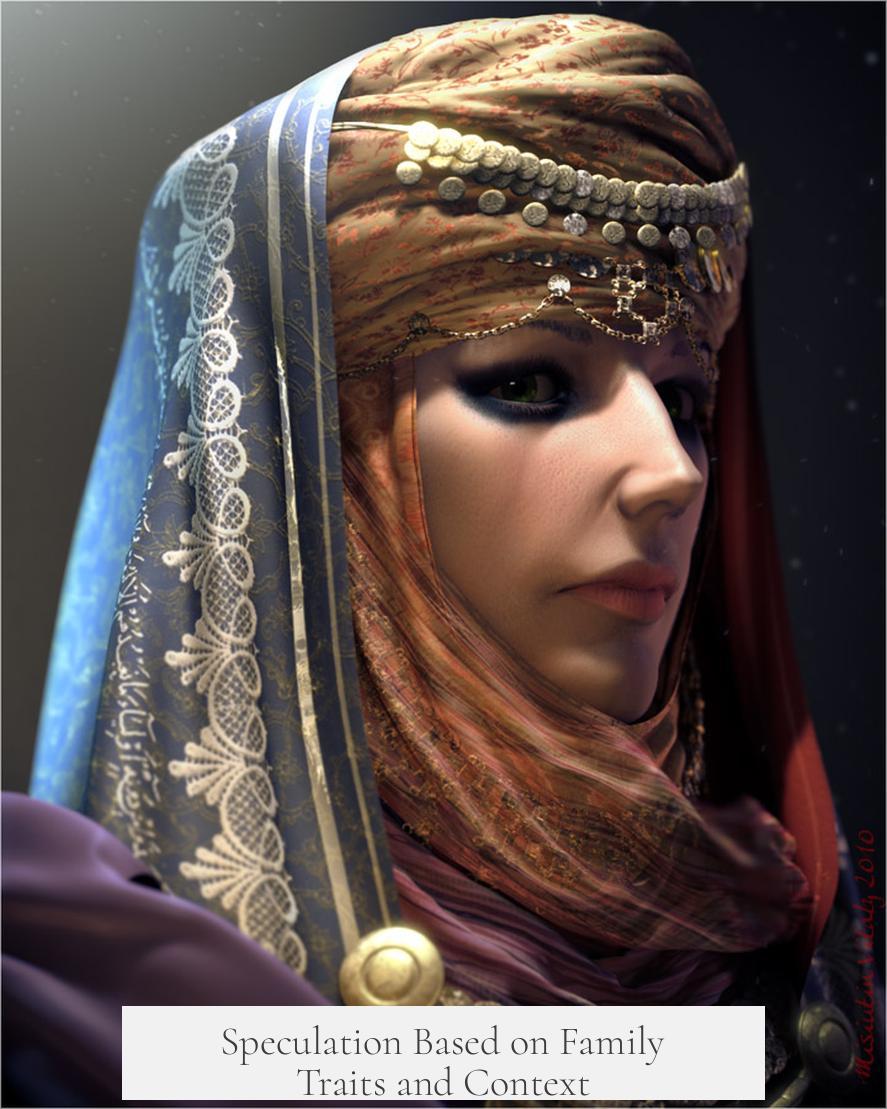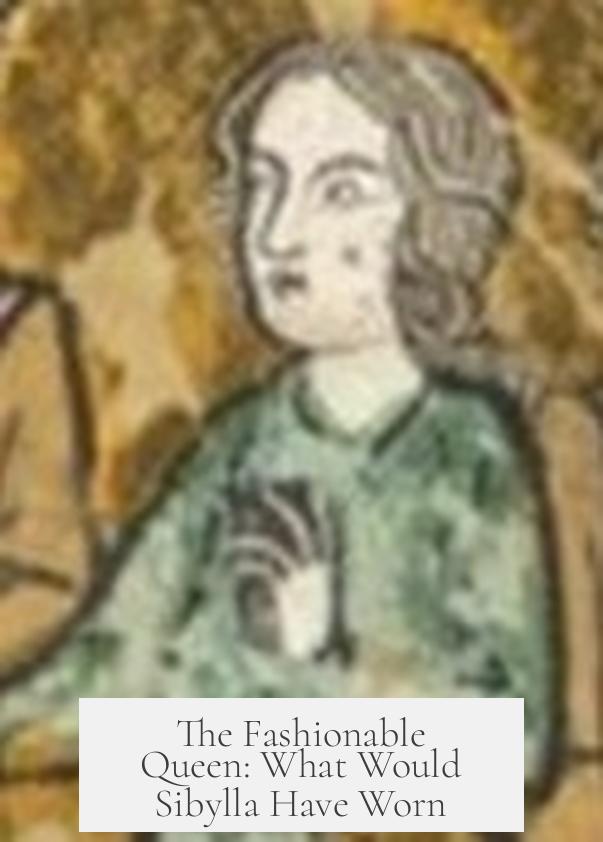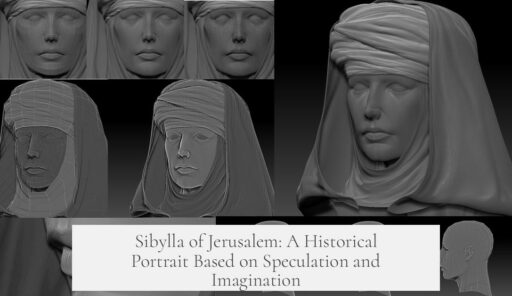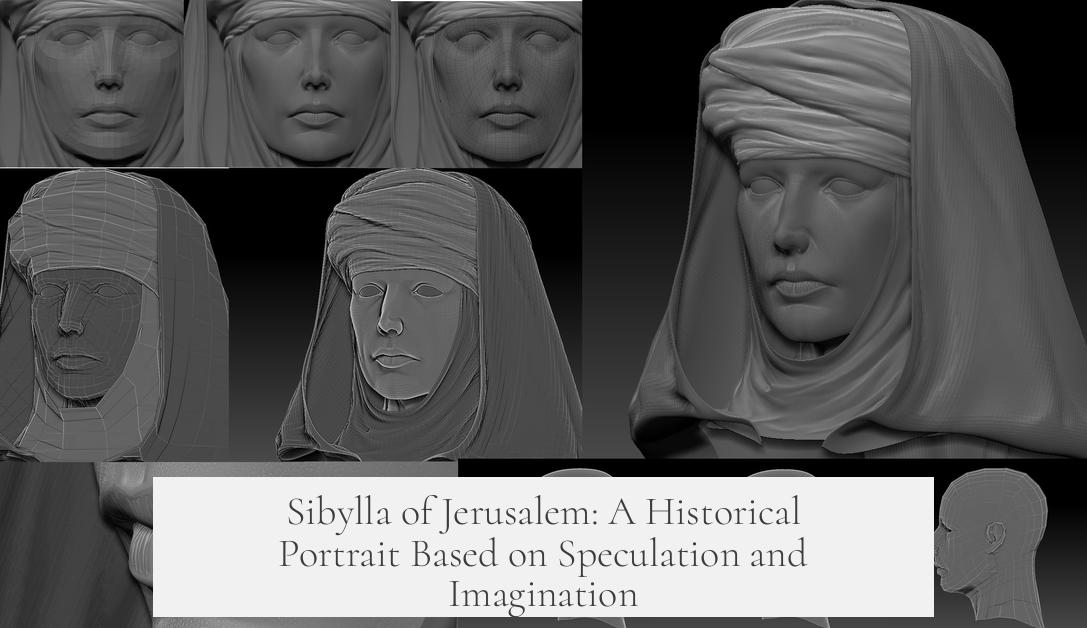There is no reliable record of Sibylla of Jerusalem’s exact physical appearance in history. Contemporary sources do not provide a description of her looks. She was raised apart from the royal court, limiting opportunities for chroniclers to observe and record her image. This lack of detail contrasts with the documented appearances of her father, King Amaury, and her brother, King Baldwin IV.
Sibylla grew up under the care of her aunt, the abbess Ioveta, at the convent of St. Lazarus in Bethany rather than in Jerusalem. This separation likely reduced public exposure and opportunities for detailed chronicling of her appearance. William of Tyre, a significant chronicler and archbishop, refrained from describing her appearance, which may reflect social norms or personal choice. As an archbishop, he might have found it inappropriate to comment on the looks of a young woman.
Family traits suggest Sibylla probably had blond hair and blue eyes, typical characteristics in her immediate family. Her father Amaury and uncle Baldwin III were described as blond and blue-eyed. Her first husband, William of Montferrat, also shared these traits. Despite her great-grandmother Morphia being Armenian, descendants like Sibylla apparently lacked distinct ethnic features associated with Armenia.
If Sibylla had been notably beautiful or unpleasant in appearance, contemporary records would likely note it. The absence of such remarks implies that her looks were average or unremarkable. This neutral stance suggests she did not stand out visually among nobles of her time.
Some 13th-century illustrated manuscripts depict Sibylla with blond or reddish-blond hair. These depictions, however, should be treated cautiously. They are centuries removed from her lifetime and likely represent generic medieval queenly imagery rather than a true likeness. Artists may have relied on tradition or symbolic coloring rather than factual memory.
Regarding clothing and overall appearance, Sibylla would have reflected typical Crusader noble fashion of the late 12th century. Crusaders in the Kingdom of Jerusalem adopted a mix of Western and Eastern dress styles, favoring loose, cooling fabrics in summer and furs in winter. Veils and surcoats helped protect the skin and armor from the sun. Some Franks even adopted turbans during this period.
Wealthy crusaders used expensive fabrics like silk and cotton, which were rare and costly in Western Europe but more accessible in the Levant. These garments typically followed Western cutting styles adapted for the climate and culture of the Near East.
Dress codes evolved over decades. In the 1120s, crusaders dressed plainly in Frankish styles and legally barred Muslim subjects from imitating them. By Sibylla’s era (around the 1180s), Crusaders had incorporated Eastern fashion elements. Contemporary European observers sometimes disparaged these styles, associating them with luxury and excess. An embassy to France and England in 1184 featured lavish dress that surprised Western courtiers and drew criticism for perceived effeminacy.
In summary:
- Sibylla’s exact facial features and build remain unknown due to a lack of contemporary description.
- Family traits suggest she likely had blond hair and blue eyes, fitting the Frankish noble lineage.
- She probably dressed in the high-style Crusader fashion of her time, mixing Western and Eastern influences.
- Later manuscript illustrations reflect idealized images rather than true portraits.
This combination of circumstantial evidence and historical context offers the clearest picture of Sibylla’s appearance possible. However, uncertainty remains, as no first-hand accounts exist.
“We have no idea what she looked like. She was almost entirely French in origin and probably had blond hair and blue eyes. She dressed typically for medieval Near East nobility, a style that struck Europeans as extravagant but was normal for her.”
| Aspect | Information |
|---|---|
| Physical Description | None contemporary; no one noted her looks |
| Family Traits | Blond hair, blue eyes typical |
| Raising Location | Convent in Bethany, separate from court |
| Cultural Fashion | Mix of Western and Eastern dress styles |
| Later Depictions | 13th-century manuscripts; stylistic, not factual |
What Did Sibylla of Jerusalem Look Like in Actual History?

Here’s the blunt truth: we just don’t know what Sibylla of Jerusalem looked like. Unlike her famous father King Amaury or her brother King Baldwin IV, there are no contemporary accounts or vivid descriptions of her physical appearance. You won’t find any mentions of her height, hair color, or eye shape in the chronicles from that era. Let’s dig into why this mystery persists and what clues historians pull together to imagine her visage anyway.
It’s a bit like trying to paint a portrait of someone whose photo was never taken, and nobody trusted an artist with a pencil. The absence of record isn’t from lack of interest but probably from real practical and cultural reasons.
Lack of Contemporary Descriptions
One might expect that the daughter of a king—**a queen no less**—would be well documented. Yet, William of Tyre, a key chronicler and archbishop who detailed her family’s members with some enthusiasm, strangely never described Sibylla’s looks. Why? Historians speculate multiple reasons:
- Sibylla grew up away from the Jerusalem court, raised by her aunt, the abbess Ioveta of the convent of St. Lazarus in Bethany. William probably didn’t meet her often enough to describe her, unlike her brother Baldwin who was in the limelight.
- There were social taboos; perhaps as an archbishop, William felt it inappropriate to comment on a young woman’s appearance.
So, no tall tales about royal curls or piercing eyes from the main chronicler. Frustrating for modern curiosity, right?
Speculation Based on Family Traits and Context

If Sibylla’s contemporaries found her stunning or strikingly ugly, surely someone would’ve said something. But no praise or criticism appears in the sources, hinting at a rather “normal” or unremarkable appearance—at least by the standards of the day.
Looking at family genetics, Sibylla likely shared the physical traits common in her lineage. Her father Amaury had blond hair, blue eyes, a bright face, and an aquiline nose—traits also noted in her uncle Baldwin III. Even her first husband, William of Montferrat, was blond. Despite having an Armenian great-grandmother, Morphia of Melitene, none of the family reportedly carried particularly distinctive Armenian features. So, blond and blue-eyed is a probable guess.
How Was She Imagined Later?
Fast-forward to the 13th century, when scribes illustrated William of Tyre’s histories. Some of these later artworks showed Sibylla with blond or reddish-blond hair. But take that with a grain of medieval salt. These were artists painting long after Sibylla’s death without any real portrait to copy. They likely depicted her as an archetypal queen—royal robes, crown, perhaps a serene expression—rather than capturing historical accuracy.
After all, medieval manuscript artists often used symbolic imagery over realism.
The Fashionable Queen: What Would Sibylla Have Worn?

So, if the details of her looks remain elusive, maybe her clothes offer hints. The Crusader states were cultural melting pots blending Western European and Near Eastern styles. Crusader nobles like Sibylla dressed in a way that balanced climate, status, and local customs.
In the blazing summers, loose-fitting, breathable fabrics kept them cool. Winters called for furs. The skin and even armor were shaded by veils and surcoats. Some Crusaders even adopted turbans to cope with heat—a fashion statement that Western chroniclers found odd, and sometimes scandalous.
Rich textiles like silk and cotton, hard to get back in Europe, were more accessible here. Crusaders often wore these fabrics in Western cuts, showing a hybrid style. By Sibylla’s time in the 1180s, Crusader fashion was evolving, blending East and West further.
One funny anecdote: an embassy led by Heraclius to France and England in 1184 dazzled with such lavish dress that the hosts thought the Crusaders were living very “effeminate” lives. Whether Sibylla joined this trend, we can’t know. But it’s safe to say she was no stranger to stylish, high-status clothing.
The Bottom Line: Who Was Sibylla, Visually?
“We have no true idea what she looked like. Probably a French-heritage lady with blond hair and blue eyes. She dressed the way any noblewoman in the medieval Near East might, part Western elegance, part Eastern adaptation—fashion-forward without the paparazzi.”
So should we care that history doesn’t give us a concrete image? Absolutely. This gap reminds us how medieval chroniclers prioritized deeds and lineage over snapshots of appearance. Sibylla’s legacy is political and cultural, not cosmetic.
Here’s a question to chew on: How different might our perception be if history had painted Sibylla’s face? Would beauty or plainness influence how we judge queens and their power? For now, Sibylla remains an elegant mystery, a queen of substance, not style.




